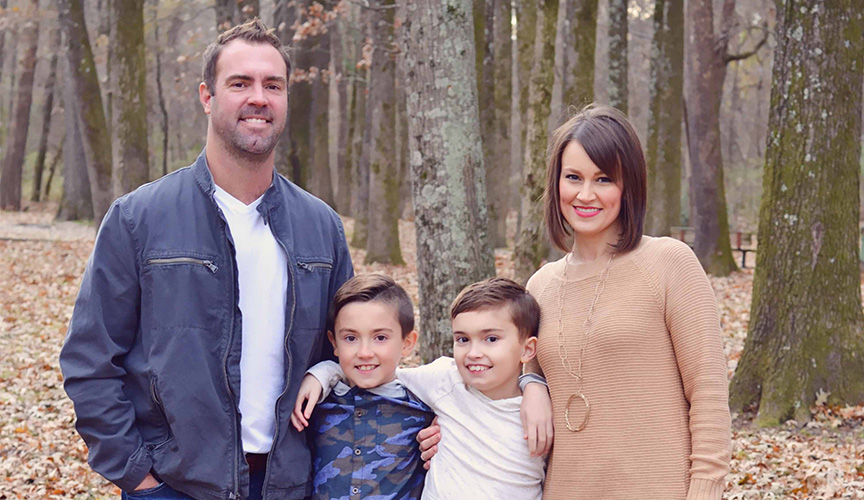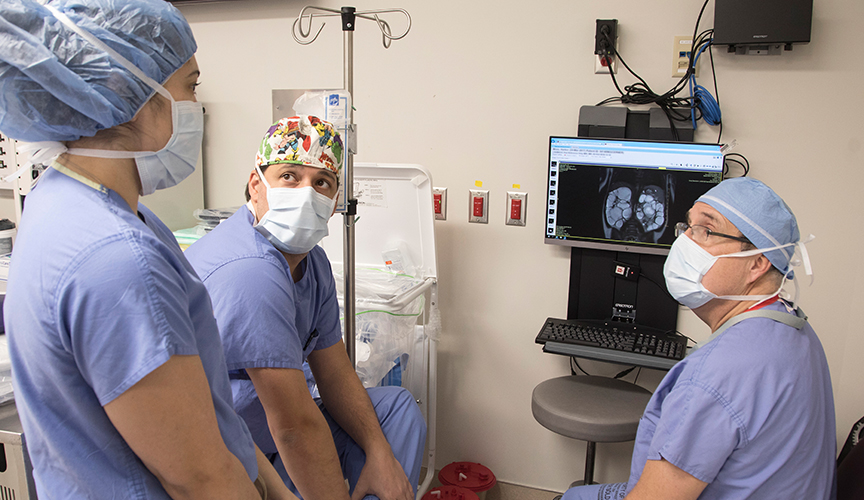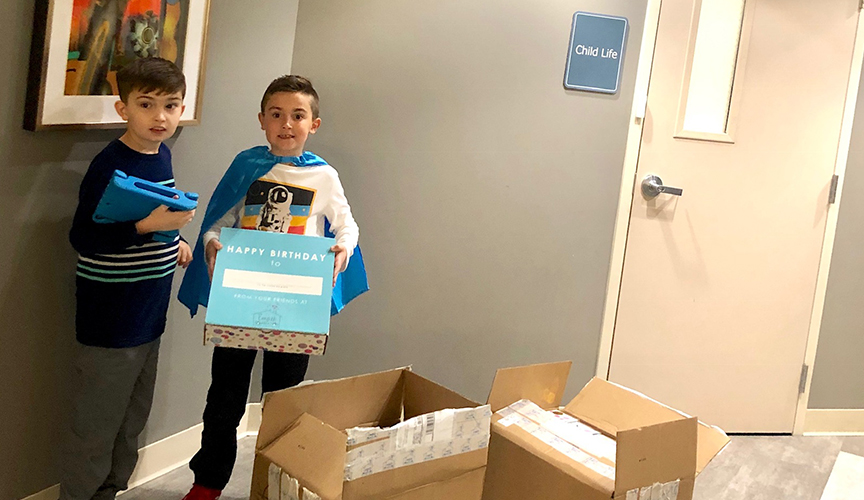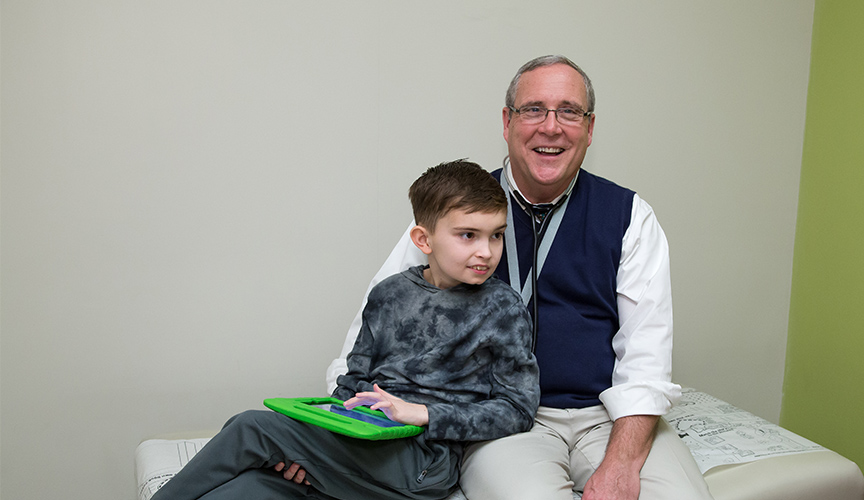Giving Support, Sharing Knowledge

When Greyson Schwaigert was 6 months old, his parents Ryan and Brittany saw an ultrasound with cysts that looked like popcorn crowding their son’s kidneys. Greyson was born with the genetic condition tuberous sclerosis complex (TSC) type 2. That diagnosis led to polycystic kidney disease (PKD), an autism diagnosis and a long road of doctor’s appointments, procedures and hospital visits.
Until recently, children with PKD like Greyson only had one option for managing cysts: an mTOR inhibitor medication that slows the excessive cell growth leading to cysts and tumors. Now, surgeons can remove the cysts and keep them from returning, thanks to a new procedure developed by Le Bonheur Nephrologist John Bissler, MD.
Recognizing the value of the care and innovation available to their son in their home town, the Schwaigerts are dedicated to giving back to Le Bonheur and the families it serves.
An Innovative Procedure
Two distinct genes have been identified to cause TSC, and mutations in either gene can cause cells to divide excessively, causing lesions – including kidney cysts – throughout the body. These cysts eventually hamper the kidney’s ability to function properly.
Recently, Ryan and Brittany found themselves making a decision that could impact Greyson well into adulthood. Should they proceed with a new procedure that would drain many of the cysts from his kidneys?
“The option for this procedure took us by surprise, but we knew we wanted to be as aggressive as possible,” said Brittany. “It was also important to address this pre-puberty before it would become more difficult to control.”
Bissler joined Medical Director of Robotic Surgery Joseph Gleason, MD, to develop a procedure to “de-roof” or decorticate, kidney cysts to drain fluid, relieve pressure and prevent cysts from returning. The ultimate goal of successful kidney cyst decortication is prolonging kidney function to delay the need for kidney transplant. In addition, the procedure lowers blood pressure and improves balance and movement.

During the procedure, Gleason removed 800 mL of fluid from Greyson’s abdomen. The change was visible and immediate as they watched Greyson’s stomach deflate and blood pressure drop when they began to drain cysts.
The Schwaigerts were back home the same day as surgery and Greyson was back to his normal self within 72 hours of surgery. Bissler has since cut his blood pressure medication in half.
“With Dr. Gleason’s reputation and role as chief of robotics and our implicit trust in Dr. Bissler a world-renowned nephrologist, we knew we had a dream team,” said Brittany. “We’ve lived Greyson’s whole life with PKD as a weight upon us. It’s a relief that we no longer have to worry about the immediate risks of his kidney cysts.”
Sharing Experiences and Knowledge
Through all of their experiences, the Schwaigerts have accumulated a wealth of knowledge – of a TSC diagnosis but also of the stresses and difficulties for families who spend time at Le Bonheur.
We wanted to give others the support that we didn’t have when Greyson was diagnosed. Sometimes you need someone to talk to who has been through a scary procedure or a surgery who can hold your hand. Other times you just need to know where to park.
“We wanted to give others the support that we didn’t have when Greyson was diagnosed,” said Brittany. “Sometimes you need someone to talk to who has been through a scary procedure or a surgery who can hold your hand. Other times you just need to know where to park.”
They are part of Le Bonheur’s Family Partners Council (FPC) – a group of parents dedicated to improving Le Bonheur’s care for children and families with the unique perspective of parents who have been through it all. This group provides direction on everything from menu options for children to what kind of wording to use in the event of a child’s passing.
“If you’re only hearing the positives, you aren’t growing,” says Ryan. “We get to review every portion of the hospital and give feedback. We feel heard.”
In fact, their experience with Greyson changed Le Bonheur’s IV and anesthesia induction policy for children with sensory processing difficulties. Greyson has frequent MRIs and requires sedation. However, he was not being sedated before the IV was given leading to some difficult and traumatic IV sticks.
After retired Le Bonheur President Meri Armour heard them discussing the issue at FPC, the Schwaigerts were meeting with the chief of anesthesiology within a week. As a result, protocols for patients with sensory difficulties changed rapidly – and Greyson could begin sedation before his difficult IV sticks.
They also find ways to involve their younger son, Lachlan, and have taught him early the value of giving back. He plays with other kids, both healthy and with medical conditions, during FPC meetings. He also helps his mom deliver boxes for the Confetti Foundation – a “birthday in a box” for children spending their special day in the hospital.
“Lachlan loves to deliver birthday boxes because he knows what it’s like to be in the hospital,” says Brittany. “It’s important to us that we expose him to kids who are different than him and to teach him the value of helping others.”

Helping TSC Families
Close to heart for Brittany and Ryan is working with families whose children share Greyson’s TSC diagnosis. Brittany is the Le Bonheur ambassador to the TSC Alliance – a position which includes everything from talking to newly diagnosed families to organizing fundraising walks for TSC.
“Through the TSC Alliance, we talk to families about their questions from surgery and medications to non-medical needs like staying at FedExFamilyHouse, kid-friendly activities in Memphis and where to grab lunch,” says Brittany. “We take pride in Le Bonheur’s TSC clinic, and we have a dedicated group of families who want to connect.”
Brittany is also an administrator of a TSC Facebook mother’s group – what started with 10 members has now grown to more than 2,500. And the Schwaigerts are always looking for ways to extend support to any newly diagnosed TSC families in need.
Thanks to innovation at Le Bonheur like Greyson’s kidney cyst procedure, options are available for treatment that the Schwaigerts would never have dreamed possible.
After five years of being non-verbal, all of the work, treatment and therapy started allowing Greyson’s personality to peek through. It wouldn’t have been possible without the help of Le Bonheur.
“Le Bonheur, its Tuberous Sclerosis Clinic and amazing physicians like [Neuroscience Institute Co-director] Dr. Jim Wheless have been so instrumental in giving us our son,” said Ryan. “After five years of being non-verbal, all of the work, treatment and therapy started allowing Greyson’s personality to peek through. It wouldn’t have been possible without the help of Le Bonheur.”
While Greyson’s journey with TSC will be lifelong, they are grateful for the immense strides in Greyson’s health that have been possible thanks to Dr. Bissler, Dr. Gleason, their research and their desire to pioneer new treatments and procedures.
“We’re donating our time, but we get so much out of it because we’ve been there as those scared, exhausted parents,” says Brittany. “Whatever you can give to an incredible institution like Le Bonheur – your money can’t go anywhere better.”

Help us provide the best care for kids.
Le Bonheur Children's Hospital depends on the generosity of friends like you to help us serve 250,000 children each year, regardless of their family’s ability to pay. Every gift helps us improve the lives of children.
Donate Now








